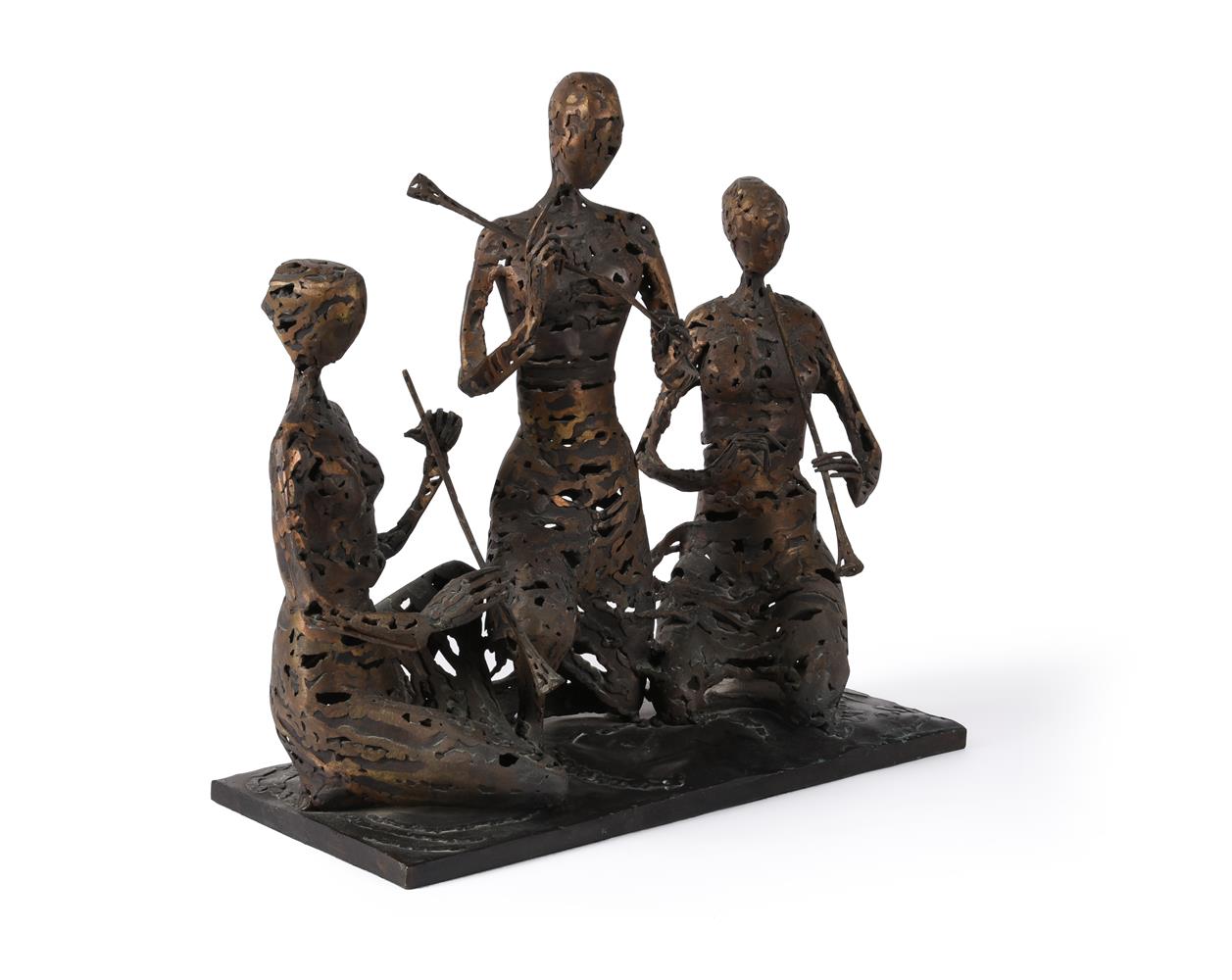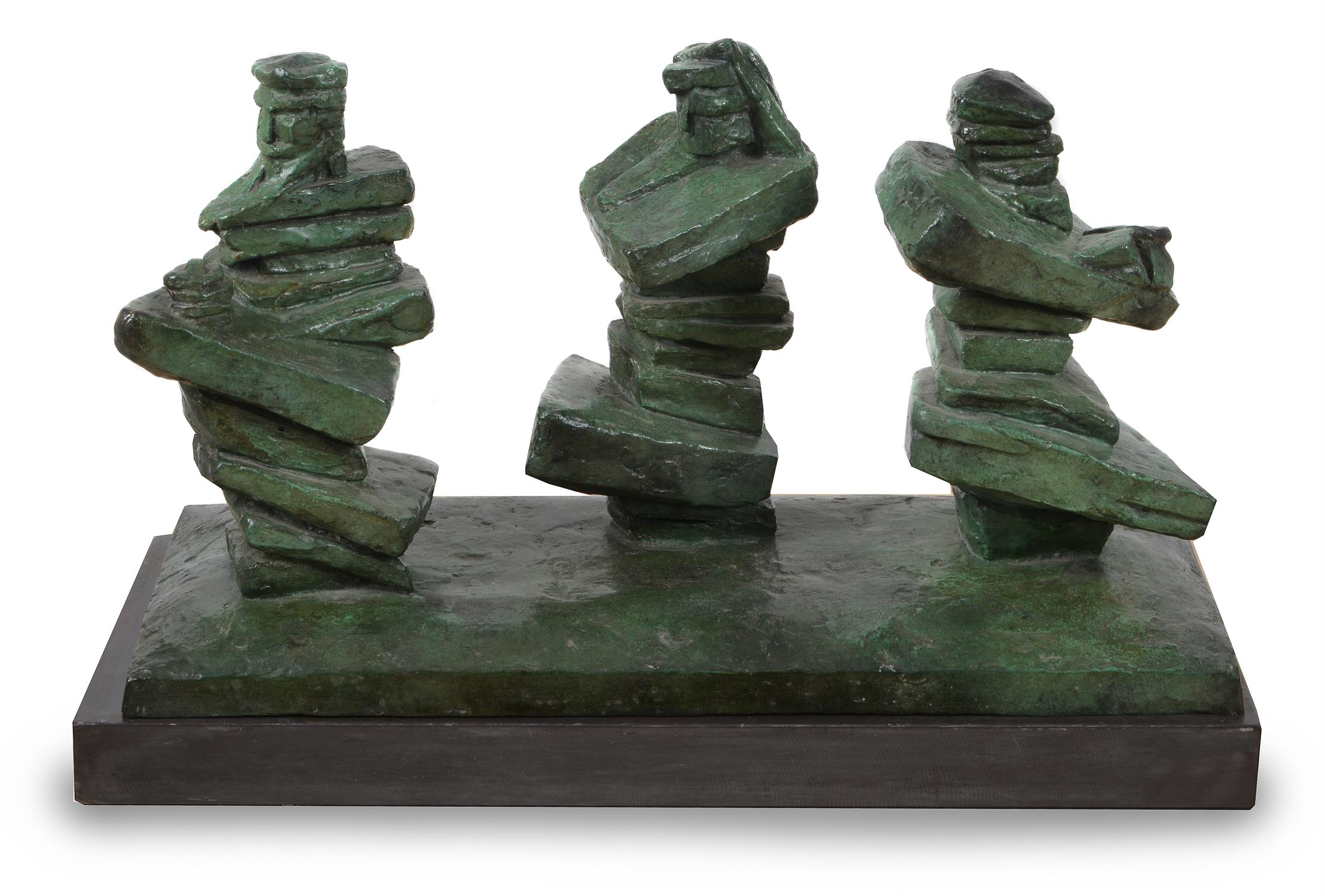Sean Crampton 1918 - 1999
Dame Kind Fabricated bronze Unique Sean Crampton was born in Manchester in 1918, the eldest son of an architect. His earliest leanings were toward the craft of silversmithing, which he studied as a young teenager at the Vittoria Junior School of Art in Birmingham from 1930 until 1933. He later attended the Central School of Art in that city, and then spent some time working on his own and at Fernand Leger~s studio in Paris. By the time war broke out in 1939, he had already joined the Territorial Army and he was soon commissioned as a subaltern in the 1st Battalion of the London Irish Rifles (London Division). He saw action in the Western Desert and in the Italian Campaign, notably in confronting the stiff German defences on the eastern side of the island of Sicily. While leading his platoon, he |displayed great gallantry and extremely high powers of leadership and devotion to duty| (as reported in the London Gazette), for which he was awarded the Military Cross. Six months later, on 19 January 1944, when the Allied armies were struggling through an appalling winter on the mainland of Italy, Crampton found himself in charge of a guide party from |A| Company (of which he was now second in command), sent out to reconnoitre ahead of the main night attack. They suddenly encountered a belt of mines, when he felt his foot treading on the igniter of one of them. The official citation summarised what happened next: Without hesitation [Lieutenant Crampton] shouted to those near him to get down while keeping his foot pressed on the mine, which went off under it, but failed to rise in the air owing to the force of explosion being taken by his foot. Lieutenant Crampton~s foot was blown off but, by his gallant action, knowing full well what the result of this was likely to be, he undoubtedly saved the lives of those near him, all of whom escaped without injury by his quick decision and personal self-sacrifice. For this further act of bravery he received the George Medal. His amputated limb inevitably took him out of the war and he required a long period of rehabilitation. In due course he was able to return to his chosen career as artist- craftsman and teacher. The years (1946-50) that he spent as Professeur de Sculpture at the Anglo- French Art Centre in St John~s Wood, London, he would subsequently look back upon as being influential in his development as a sculptor; they witnessed his increasing technical mastery and creative adventurousness, which went hand in hand with his own inspirations - his love of mythology, history (both human and natural) and the deeper world of the spirit. Besides exhibiting at the Royal Academy and other institutional galleries, Crampton held 17 one- man shows in the West End over a period of nearly four decades. Works on a more heroic scale were commissioned by civic organisations, colleges (two at Cambridge), churches and convents. Some found their home on remote and rugged sites, while other figures on religious themes would reflect events from the Gospel story. He was particularly gratified when he was asked to create the war memorial for his own regiment. Several of his most notable works earned him awards from the Civic Trust and from the Royal Society of British Sculptors. He had been a member of that body since 1953 and served as its president for five years (1966- 71). His wise counsel and the fruits of his long experience were also in demand from other associations concerned with the arts: for a time he was chairman of the College Council at Camberwell School of Art, and then a governor of the London Institute when it absorbed a number of the leading art schools in the metropolis. He had been an active member of the Art Workers~ Guild and in 1978 was elected its Master.
Sean Crampton 1918 - 1999
Dame Kind Fabricated bronze Unique Sean Crampton was born in Manchester in 1918, the eldest son of an architect. His earliest leanings were toward the craft of silversmithing, which he studied as a young teenager at the Vittoria Junior School of Art in Birmingham from 1930 until 1933. He later attended the Central School of Art in that city, and then spent some time working on his own and at Fernand Leger~s studio in Paris. By the time war broke out in 1939, he had already joined the Territorial Army and he was soon commissioned as a subaltern in the 1st Battalion of the London Irish Rifles (London Division). He saw action in the Western Desert and in the Italian Campaign, notably in confronting the stiff German defences on the eastern side of the island of Sicily. While leading his platoon, he |displayed great gallantry and extremely high powers of leadership and devotion to duty| (as reported in the London Gazette), for which he was awarded the Military Cross. Six months later, on 19 January 1944, when the Allied armies were struggling through an appalling winter on the mainland of Italy, Crampton found himself in charge of a guide party from |A| Company (of which he was now second in command), sent out to reconnoitre ahead of the main night attack. They suddenly encountered a belt of mines, when he felt his foot treading on the igniter of one of them. The official citation summarised what happened next: Without hesitation [Lieutenant Crampton] shouted to those near him to get down while keeping his foot pressed on the mine, which went off under it, but failed to rise in the air owing to the force of explosion being taken by his foot. Lieutenant Crampton~s foot was blown off but, by his gallant action, knowing full well what the result of this was likely to be, he undoubtedly saved the lives of those near him, all of whom escaped without injury by his quick decision and personal self-sacrifice. For this further act of bravery he received the George Medal. His amputated limb inevitably took him out of the war and he required a long period of rehabilitation. In due course he was able to return to his chosen career as artist- craftsman and teacher. The years (1946-50) that he spent as Professeur de Sculpture at the Anglo- French Art Centre in St John~s Wood, London, he would subsequently look back upon as being influential in his development as a sculptor; they witnessed his increasing technical mastery and creative adventurousness, which went hand in hand with his own inspirations - his love of mythology, history (both human and natural) and the deeper world of the spirit. Besides exhibiting at the Royal Academy and other institutional galleries, Crampton held 17 one- man shows in the West End over a period of nearly four decades. Works on a more heroic scale were commissioned by civic organisations, colleges (two at Cambridge), churches and convents. Some found their home on remote and rugged sites, while other figures on religious themes would reflect events from the Gospel story. He was particularly gratified when he was asked to create the war memorial for his own regiment. Several of his most notable works earned him awards from the Civic Trust and from the Royal Society of British Sculptors. He had been a member of that body since 1953 and served as its president for five years (1966- 71). His wise counsel and the fruits of his long experience were also in demand from other associations concerned with the arts: for a time he was chairman of the College Council at Camberwell School of Art, and then a governor of the London Institute when it absorbed a number of the leading art schools in the metropolis. He had been an active member of the Art Workers~ Guild and in 1978 was elected its Master.










Try LotSearch and its premium features for 7 days - without any costs!
Be notified automatically about new items in upcoming auctions.
Create an alert